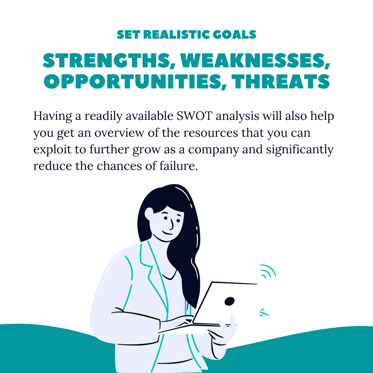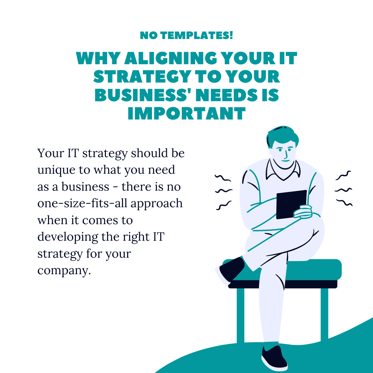
IT’s role in the development and execution of business strategies has significantly grown in an era where technology is king. It doesn't matter if you're a big corporation or a startup looking for IT support. As long as the rate of business and technology steadily accelerates, startups are going to find it difficult to catch up.
READ MORE: THE TOP REASONS A BUSINESS SHOULD BE USING MANAGED IT SERVICES
You might be wondering, I’m just a mom and pop store why do I need an IT support strategy? Chances are, you probably don’t – at the moment. But if you’re thinking three, four, five years from now and your business is expanding, don’t you think even the simplest IT strategy should be in place to protect you, your business, your customer’s information, and your intellectual property?
Don't worry! ETech 7, a leading managed IT service provider in New York City, has come up with the ultimate IT strategy checklist that would help your startup flawlessly ride the digital transformation wave… Surf’s up! Get it…? No…? Okay.
What is an IT Support Strategy for?

The first – and probably the most important – step is to determine what your IT strategy is for. Primarily, your IT strategy's function should be to support whatever your business needs. However, this will always be easier said than done.
Truth is, depending on the magnitude of your IT strategy, it will almost always involve the big guns. Meaning the CEO, the CIO, the COO, and other members of upper management should all have a say in your IT strategy. This might not be the case for all of your IT strategies/plans but, in most cases, it is advisable to seek their input and combine it with your ideas. IT strategies/plans should always align with your business’ goals.
Last but not least, upper tech management should also define where technology fits. A quick review of all the different facets of your organization would be the best (and easiest) way to gain perspective. With perspective comes an overview of where technology will fit in your startup – thus minimizing the risk of spending money on technology that you don’t actually need.
What is an IT plan?

We. Cannot. Reiterate. This. Enough. Let's face it - creating a strategy can be particularly nerve-racking. But, with the proper planning, startups may be able to minimize the risk of failure. IT teams usually come up with either quarterly or yearly plans. While many might say that quarterly or yearly plans seem pretty standard – it, again, will always boil down to what your company needs.
Asking your startup “Where are we going?”, “Where are we headed?”, and “What are we trying to achieve?” may help your startup come up with an attainable and sustainable IT strategy for your business. However, companies should also understand that a strategy is only a guide and an operating procedure – it is NOT a direct response to unpredictable crises. That’s where contingency plans come into play – including a contingency plan in your IT strategy will help you respond to an unpredictable circumstance in a timely and efficient manner.
Planning your IT plan requires incredible and – with luck – accurate foresight. Take advantage of the many minds involved in your startup. Ask their input, embrace criticism, and try to predict everything that could go wrong. But how do you develop an IT strategy? And what should be in an IT strategy?
Pro Tip: Conduct a SWOT Analysis

Conducting a SWOT analysis will help you determine key internal and external factors that amplify your company’s strengths, expose your company’s weaknesses, capitalize on different existing opportunities, and identify potential threats that might hinder your startup’s growth.
Having a readily available SWOT analysis will also help you get an overview of the resources that you can exploit to further grow as a company and significantly reduce the chances of failure.
Another Bonus Pro Tip: Align your plan with how much budget you have and what objectives you are going to pursue
Pretty self-explanatory, right? WRONG. Setting a realistic goal that is aligned with the resources that you have is ALWAYS a good idea.
What are the main points of an IT strategic plan?

Now that you have identified where your startup stands and what your IT strategy is for – it is now time to establish your SMART goals. If you’ve been living under a rock and have no idea what SMART goals are - let us walk you through.
SMART goals stand for Specific, Measurable, Attainable, Relevant, and Timely. By using SMART goals, you can gauge what you can achieve and how well you can execute your strategy. Essentially, SMART goals work well with short to long-term projects since it provides a clear overview of what the company expects from the project and, in turn, also provides team members with clear tasks.
Still scratching your head? See example below:

Notice the difference? It’s easy to say what you want to happen but setting a realistic goal for your startup takes a little bit more than guesswork. Setting a goal may only go two ways – either success or frustration. Again, however, it all boils down to what your company needs and how attainable the goal is.
Align your IT strategy framework with your goals
Ahh, the end game. Where do you even begin? What KPIs did you monitor? How much money did your IT strategy save/make you?
We know that for a startup, it can be particularly daunting to have all these technical IT terms thrown all around without any idea what they are and what they are for. Don’t fret, ETech 7 is here to break it down for you!
Before we go over the nitty-gritty details, we need to reiterate that there is no one-size-fits-all when it comes to the perfect IT strategy. It is always best practice to know your company first before knowing what it needs. There are a lot of resources available on the internet for your startup to be able to develop a customized IT approach for your company – Tedious? Yes. Worth it? Of course.

Although a lot of IT experts will argue, monitoring ROI should be the least of your worries since the mission of IT is to support your business strategy and make business functions more effective and efficient. For instance, monitoring ticket turnover and overall IT support performance is essential in ensuring that your IT support NYC team is on top of everything. Factors including the speed it takes to resolve downtime, the mean time to repair unexpected issues/crashes, and the number of errors/crashes that occur in a specific time period should be some of the things that your IT team should be on top of to be able to measure your ROI.
The basic ROI mechanics for your startup should be on a practical level – meaning if you spend $10 and make $15, your net gain is $5. So basically, the formula should be:
ROI = (gain on investment – cost of investment)/cost or more simply net gain/cost
However, the most difficult question is – is it worth to measure your IT efforts’ ROI?
We’re glad you asked. The answer will, almost always be, yes.
Pros of Monitoring your IT Efforts
- Technology makes your business functions easier while making your operations more efficient
- Ease of tracking projects and business operations
- New tech means new data analytics to measure. This results in process improvement, overall lowering costs, and improving your startup’s overall ROI
Are there any Cons?
- If used inefficiently, your IT efforts might prove to be costly
- Most of the time, startups don’t use their technology to its full use
- Investing in tech might be a little bit costlier for a startup’s limited budget – it is important to absolutely narrow down to the tech you most certainly need and just add on to whatever you have later on

Now that you have a bit of a grasp of how important your startup’s IT overview is – you must now understand how to break all of them down.
Questions like…
“How much does it cost for your IT operations to keep going?”
“Were there poor estimations?"
"Are there potential issues that might make you go over your IT budget?”
“Is your startup investing in the right technology?”
…should be asked in order to understand that your IT strategy WILL NOT directly generate revenue but will definitely affect profit generation.
Responsibly spending your money to keep your startup’s costs in check is absolutely necessary to become successful. After determining the hows and the whys of your IT operational costs, it is time to identify where your startup is spending its money.
- IT Cost Estimation Worksheet – In layman’s terms, the cost estimation worksheet will allow you to predict the cost of completing an IT operation with a definite scope and limitations. It is important to note however that cost estimates are typically revised and updated as the operations become more precise and when risks are foreseen.
- IT Cost-Benefit Analysis Worksheet – Another important worksheet to consider is the cost-benefit analysis. Cost-Benefit Analysis will allow your startup to move forward or back away from an important business decision. Having no cost-benefit analysis before making a huge business decision will result in loss of time and money.
- IT Expenses Over Time Worksheet – Having an expense over time worksheet allows your business to compare whether or not your IT efforts have either been contributing positively or negatively to the larger scheme of your business operations.

Understandably, your IT efforts should be aligned with your startup’s overall strategy. However, did you know that your IT efforts should also be customized when a particular project comes along? *GASP!*
Yes. It sounds like a lot of work – but again, hear us out!
According to IT consultants VertitechIT, project alignment KPIs should include response rates, cost reductions, cost avoidance, revenue enhancements, capital reduction, and capital avoidance. Sounds tricky, right? But going back to the simple ROI equation (net profit/cost of investment) will always allow you to re-align your budget to what your project needs. It is important to remember that definite ROI figures would only manifest measurable gains.
Factors such as customer satisfaction, improved customer support, and better resolution times are, in our opinion, better indicators that your IT efforts are working.
We probably sound like a broken record by now but remember, your IT efforts and your business strategy should always align with your startup's overall needs. We’re not saying that you should limit it to ONLY what you need – you should also align it with your business’ future and where you think your needs are headed. Having the right tools and the right foresight would let you and your startup better adapt to wherever technology leads this digital age.
You can always look into strategy consulting or IT consulting services.
Here at ETech 7, we strive to provide superior quality consulting services for all of your IT strategy needs. This blogpost is merely a brief checklist of some of the most important things to consider when developing a great IT plan. Any business of meaningful size needs computer networking, backup and disaster recovery. ETech 7 allows companies to outsource professional setup, routine maintenance, emergency assistance, and project development.

- Know your business in and out!
- Align your IT support strategy with your business strategy
- Your IT strategy should be unique to what you need as a business - there is no IT strategy template
- IT strategic plans should have a clear goal, a SWOT analysis, a viable action plan, and a fixed timeline
- REMEMBER: Customer satisfaction is equally important to measurable IT KPIs that contribute to definite ROI.
Til next time!












